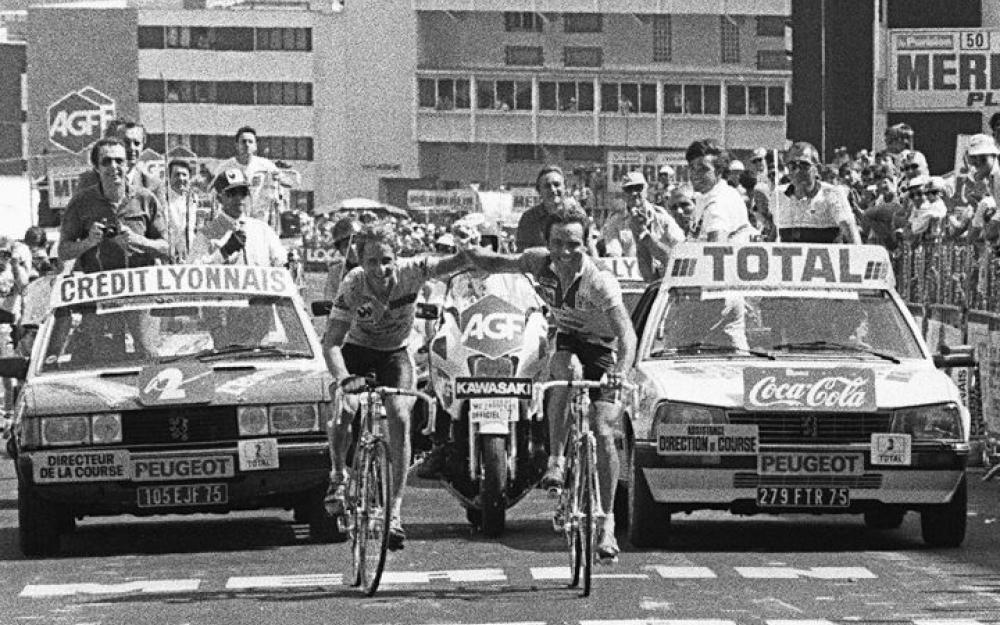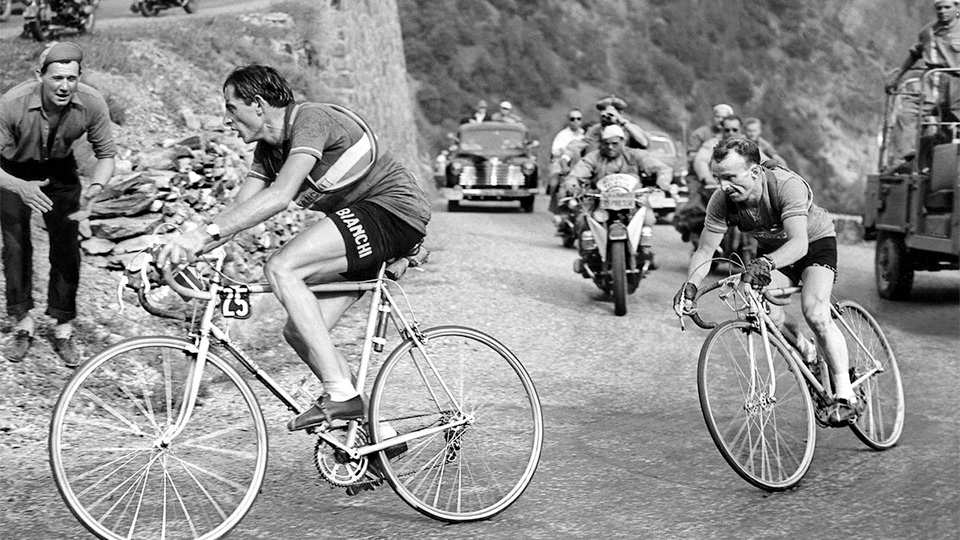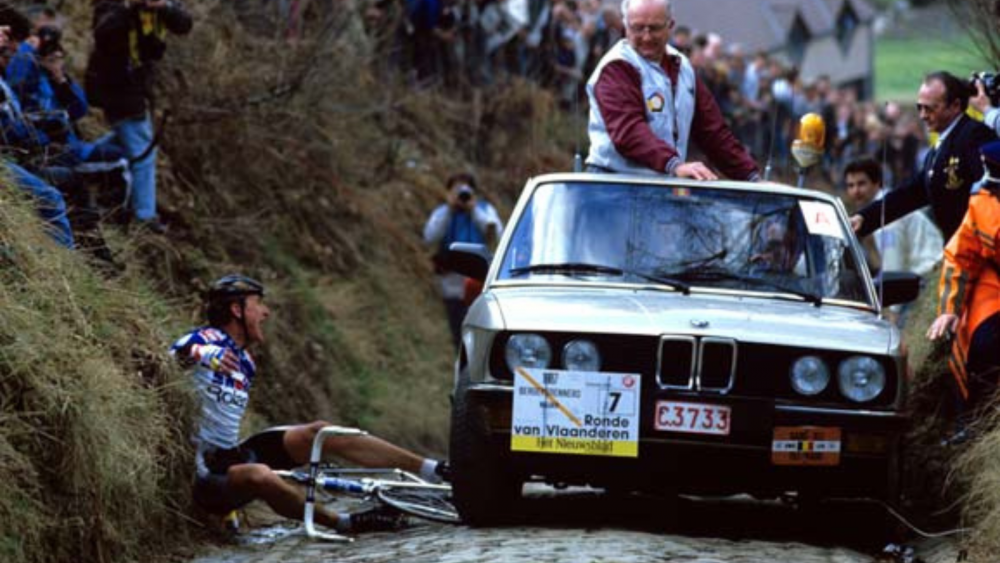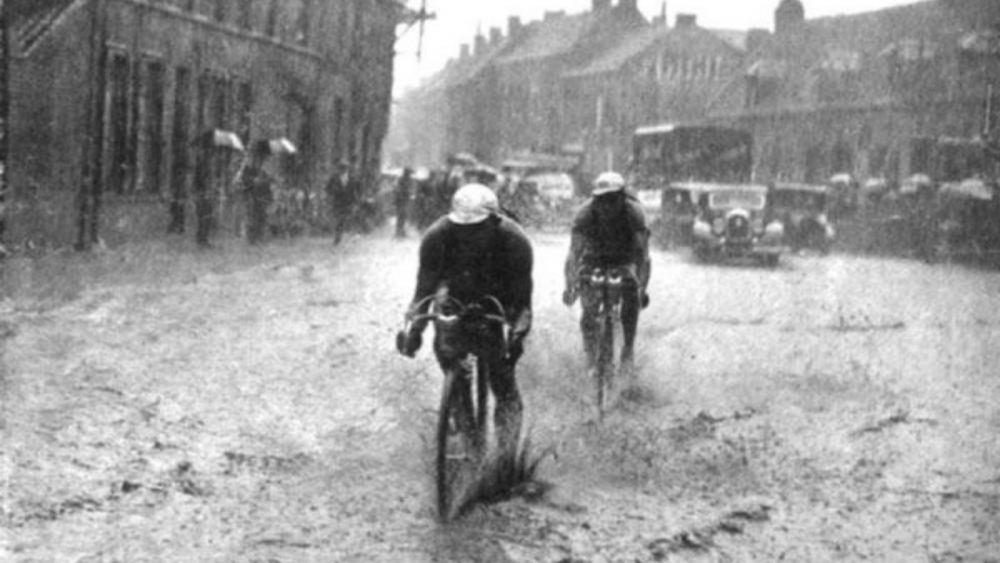Alpe d’Huez witnessed plenty of legendary moments since its introduction to the Tour de France in 1952. One of them is the famous 18th stage in 1986, when Bernard Hinault and Greg LeMond reached the top hand in hand.

The team La Vie Claire had usually a very strong line-up at the Tour de France in the mid-1980s. Bernard Hinault was one of the cycling superstars, the second French rider after Jacques Anquetil, who won the Tour de France 5 occasions (1978, 1979, 1981, 1982 and 1985)1
But Hinault had a young American teammate, Greg LeMond, strong enough to be his greatest rival, if they would not have been riding in the same team.
Previously…
In 1985, it was clear, that the whole team was working on Hinault’s 5th victory. Unfortunatelly, the French rider crashed badly and broke his nose on the 14th stage, which caused further problems on the next few stages. Especially on the 17th stage, when he dropped, while LeMond was told no to work together with Stephen Roche for a successful attack. Roche, who heard the conversation between the La Vie Clair team car and their rider, won the stage. LeMond felt betrayed by his team of the chance of winnig the Tour.
Hinault remained in the yellow jersey till Paris. LeMond, who considered to leave the race after stage 17, but was persuaded to continue it, finished second.
Before the Tour de France in 1986, Hinault promised to support his teammate during the upcoming race. But there were plenty of signs during the race, that his promise might have been not an honest one. This lead to a rift between the two riders.
Hinault lost his first GC position on the 17th stage, after struggling and dropping back on the Col de Izoard. Now, Greg LeMond was the leader of the race and the first US rider to wear the yellow jersey.
The iconic 18th stage
Next day, Tour de France visited Alpe d’Huez. The 162,5 km long stage started in Briançon. The peloton climbed Col du Galibier, rode through Col du Télégraphe downhill, then came Col de la Croix de Fer, before L’Alpe d’Huez at the end of a hard day in the saddle.2
Bernard Hinault accelerated several times during the early part of the stage. Before crossing the Télégraphe, he attacked the bunch of the favourites seriously. Meanwhile, LeMond was told rather to attack Urs Zimmermann, the second rider in the general classification, instead of working with him to join Hinault (and some other breakaway riders of lesser importance).
Nevertheless, LeMond was able to open a gap between him and Zimmermann before Col de la Croix de Fer started. Also he managed to join to the breakaway trio at the front.
Soon the other riders dropped, only Hinault and LeMond left.
Shortly before the finish line, LeMond put his arm around Hinault and had a short conversation with him. Then Hinault took LeMond’s hand. They crossed the finish line together, with Hinault taking the stage win.
Want more Alpe d’Huez?

Alpe d’Huez, the instant classic
There is a simple reason, why Alpe d’Huez was introduced to the Tour de France only in 1952, while the race visited the Alps since 1911 frequently: there is only one way up to the top, hence the stage must be finished there. But the concept of a hilltop finish wasn’t born yet. Indeed, the … Read more

The first hilltop finish of Tour de France
Although smaller climbs were parts of the program since the beginning, and both the Pyrenees (1910) and the Alps (1911) were intruduced to the race during the pre-WW1 period, there were no hilltop finishes at the Tour de France till 1952. Alpe d’Huez ( in the Western Alps) was a ski station in the first … Read more

5 iconic Alpe d’Huez moments
With its introduction to Tour de France in 1952, Alpe d’Huez became one the most iconic ascents of the race instantly. Although it has a shorter history than the big giants like Col du Galibier or Col d’Izoard, there are plenty moments worth to remember. Let’s see five really iconic moments from the common history … Read more
If you like PelotoTales, you can support the blog with a small donation via PayPal
Read the stories of other iconic vintage cycling images:

Jesper Skibby’s crash on the Koppenberg (Ronde van Vlaanderen 1987)
In 1987, Skibby rode solo at the head of the race, when he reached Koppenberg. He had an advantage of two minutes, but climbing the hill he became slower and slower and the peloton came closer. The car of the race commissaire followed Skibby so close, that when they wanted to move away, the car … Read more

Bernard Hinault and Greg LeMond on the top of L’Alpe d’Huez (Tour de France 1986)
Alpe d’Huez witnessed plenty of legendary moments since its introduction to the Tour de France in 1952. One of them is the famous 18th stage in 1986, when Bernard Hinault and Greg LeMond reached the top hand in hand. The team La Vie Claire had usually a very strong line-up at the Tour de France … Read more

Pouring rain at the Tour de France 1936
The first stage of Tour de France in 1936 run in pouring rain.